I installed Ubuntu and realized that some programs weren't compatible with Linux. I tried Wine but it didn't help, it still supported nothing. So, I decided to dual boot Windows. I went to disks on Ubuntu and formatted the flash drive. Restarted and- NOPE. It wasn't a bootable drive. How can I find a ISO burner that makes bootable on Ubuntu that burns Windows ISOs and not just Linux distros?
-
Also can use this method to make partition bootable: http://askubuntu.com/questions/473641/make-boot-partition-using-gparted-in-boot-repair – AnotherKiwiGuy Nov 21 '16 at 05:50
2 Answers
The preferred method here is to use dd. This will wipe your USB drive, so be sure to back up anything you want from it before following this guide.
I've copied directions of the website linked to preserve it in one place.
For Command Line Lovers
For command line lovers like me the best utility to burn a .iso to USB drive is dd.
- Insert the USB drive and open terminal (Ctrl+Alt+T)
- better be a root (
sudo -i), don't be afraid believe in yourself - use
fdisk -lto find the USB device
So in our case it's
/dev/sdb, because it's 8GB (8046MB)Make sure the USB device is unmounted:
umount /dev/sdb1Change your working directory to wherever your .iso is located, typically:
cd /home/yourusername/Downloads(we don't use~because we're logged in as root)Assuming the .iso file is in your current working folder, type the below command and wait for it to finish:
dd bs=4M if=name_of_windows_iso.iso of=/dev/sdb
If you have Ubuntu 16.04 or newer, you can add the status=progress option to see how far along it is:
dd bs=4M if=name_of_windows_iso.iso of=/dev/sdb status=progress
If you have an older version of Ubuntu or are not sure, you can use pv to view the progress of the transfer:
dd bs=4M if=name_of_windows_iso.iso | pv --size 4G | of=/dev/sdb status=progress
You'll want to change the "4G" to reflect the approximate size (in gigabytes) of your ISO. This is so that pv can give you an estimate on when the transfer will be done.
Testing Time...
To test if everything has gone right, boot your system from the USB drive. To do so you will have to reboot your system. To avoid this, we can use QEMU. QEMU can help you in this. What?! Yes QEMU is a machine emulator and virtualizer.
Make sure qemu is installed (apt-get install qemu)
Run the below command and you will see a virtual machine booting from your USB Drive:
qemu -hda /dev/sdb
- 3,012
- 617
Brasero and k3b are linux tools to burn DVD disks. I like k3b better but both work. It is important to 'burn an image' or 'burn an iso file'. (You should not make a data-DVD and copy the iso file to it.) Afterwards, when you insert the DVD disk, you should see several directories and files. If you see only one file, the iso file, you used the wrong method.
-o-
But the modern way to do this is to clone the iso file to a USB pendrive. It can be done with dd, which is a very powerful but also dangerous tool. It does what you tell it to do without questions. If you tell it to wipe the family pictures ... and it is only a small typing error away. For this reason I suggest that you use mkusb or mkusb-nox, which 'wrap a safety belt around dd'. mkusb-nox can create a USB install drive for Windows 7-10.
Install mkusb and mkusb-nox with the following commands. If you run standard Ubuntu, you need an extra instruction to get the repository Universe. (Kubuntu, Lubuntu ... Xubuntu have the repository Universe activated automatically.)
sudo add-apt-repository universe # only for standard Ubuntu
sudo add-apt-repository ppa:mkusb/ppa # and press Enter
sudo apt-get update
sudo apt-get install mkusb mkusb-nox usb-pack-efi
See more details at
- 46,324
- 5
- 88
- 152
